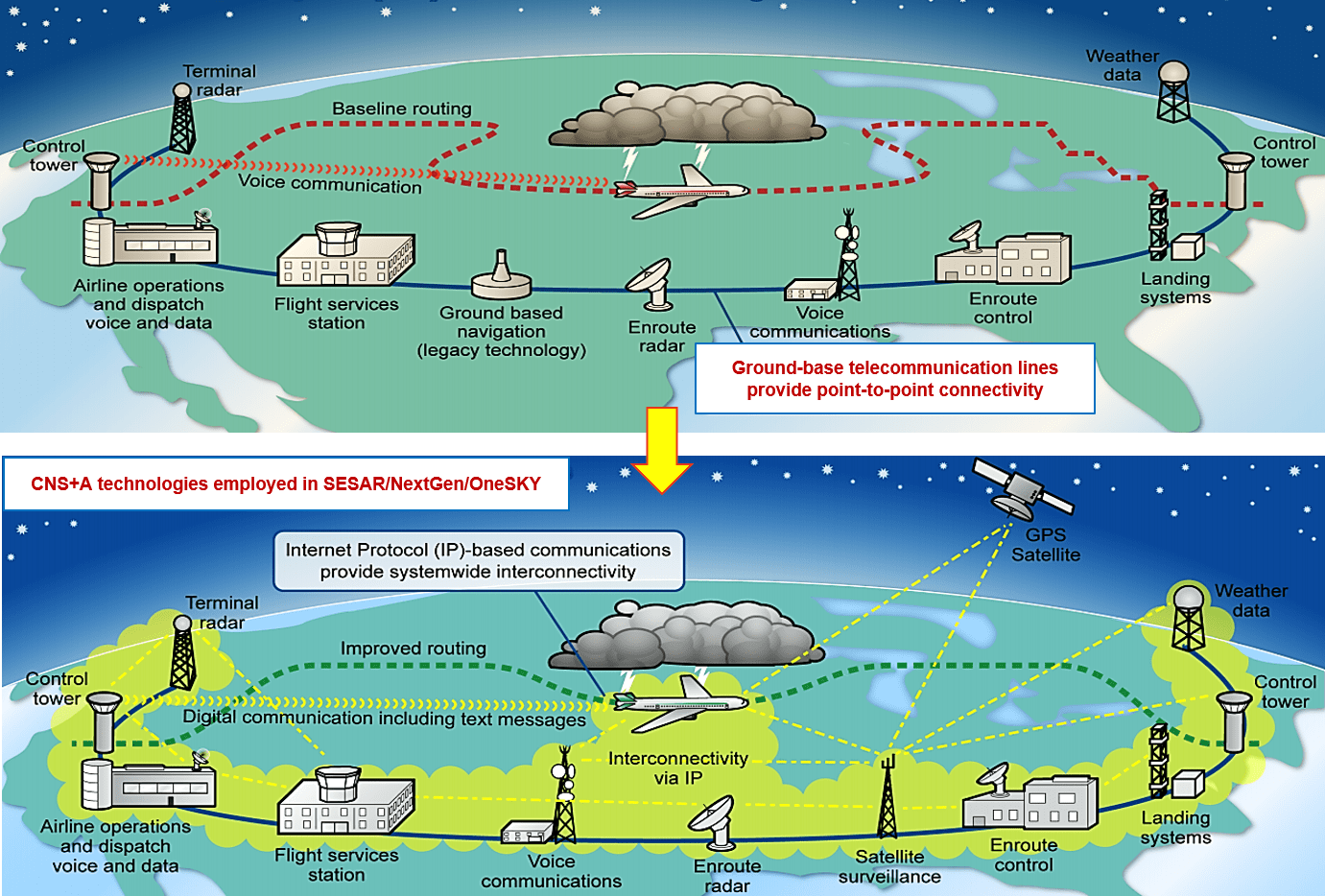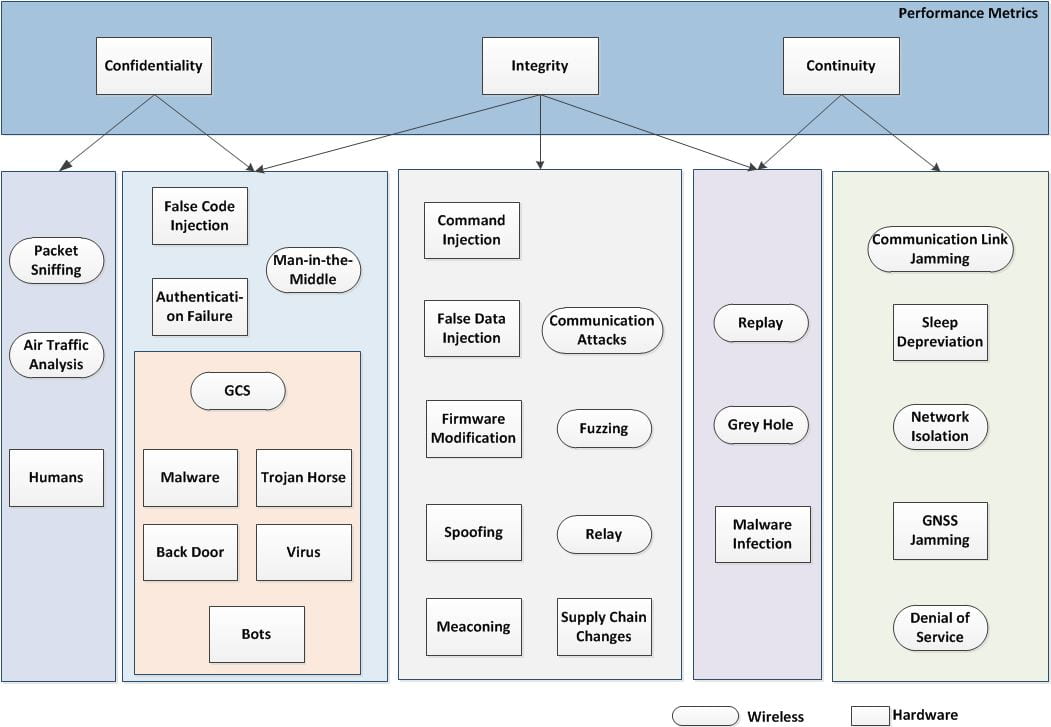Cyber-Physical Systems Security
The evolution of aircraft technology and global transport has ushered in new developments as well as maintained common themes. Avionics and Air traffic management (ATM) systems are continuously evolving to enhance fuel efficiency, safe travel and passenger satisfaction. All of these technologies are regulated through airworthiness certification, operational regulation and technical standards for interoperable aerospace systems.

The current global airspace management system is afflicted by several issues:
- Aging communication systems: mostly based on analogue voice radiocommunication
- Disjoint set of networks: preventing data to flow seamlessly from one point to the other
- Currently not globally network centric: still relying on some human operator to process and exchange data
- Evolved over time with limited concern for network security
- Security by obscurity
- Closed systems
- Insufficient bandwidth to support security measures
- Safe and Secure
- Air Traffic Control methods have evolved in reaction to changes in technology, capacity and use
- Current methods are reaching limit of scalability
To bring safety to the skies, it is essential to provide develop and implement more efficient and robust airspace management schemes matching the requirements of user-defined 4D trajectories and intent-based operations. This cannot occur unless the current CNS/ATM infrastructure and onboard avionics systems evolve to allow network-centric operations. This transition will require the following additional measures:
- Cross network security
- Authentication, Authorization, Accounting and Encryption
- Required changes in Policy
The cyber world of interconnected and interdependent systems has increased the vulnerability of aircraft and systems and therefore the potential impact that breaches in security can have. A cyber security framework is needed to address the following key issues:
- Cyber Security threats have the potential to compromise aviation safety
- Cyber Security threats have the potential to cause major efficiency disruptions
A cyber vulnerability assessment (CVA) is required to determine the health and robustness of system performance due to both internal threats (e.g., power failure, software errors, and human error) and external threats (e.g., environment, adversary, and other systems). Current constructs include the system devices include Unmanned Aerial Vehicles (UAVs). The link between GPS and IoT will require testing and monitoring of equipment to attacks. The combined system includes many of the hardware and software developments.

Cyber-security was largely inherent in traditional ATM systems thanks to the limited or null interconnectivity between dedicated CNS/ATM subsystems. However, current ATM requires highly interconnected Decision Support Tools (DST) addressing the requirements of both strategic and tactical operational timeframes.
Currently, Air Navigation Service Providers (ANSP) implement the following CS measures:
- Online submission of flight plans and flight plan amendments can only be performed by
authenticated and authorized users and is subject to very detailed scrutiny (checks are
performed to avoid any intentional/unintentional duplication in flight crew, aircraft, call-sign). - Authentication and user restrictions especially in relation to external entities participating
to the CDM process (airlines, weather offices, handling agents, airport management, etc.) - Encryption and tunnelling (IP-based interconnectivity): increasingly adopted for ground-based
telecommunication network
Automatic Dependent Surveillance Broadcast (ADS-B) is becoming a major cornerstone of aircraft de-confliction. Three types of threats ADS-B message have been identified:
- Message Corruption
- Message Denial
- Message Delay
ADS-B is inherently vulnerable to hacking, jamming, spoofing and meaconing because of its open architecture and unencrypted signals, and because equipment is easy to obtain
Encryption and tunnelling (IP-based interconnectivity): increasingly adopted for ground-based telecommunication networks provide measures of development that continual need to be designed to ensure that that methods are not subject to attack. Essential to these methods are the confidence, integrity, and availability (continuity) of the signals being used processing by avionics systems for effective performance. Example threats that can severely affect future systems can be categorized as firmware (software) and network (physical) attacks.

Research Projects
Cyber systems and data security
- Information security and assurance – anomaly detection, interference in heterogenous,
IoT and software defined networks, coding theory, risk management - Big data – clustering and classification of complex networks, subgraph and motif detection,
dynamics and prediction, matching across databases - Combinational designs: theory and applications – Hadamard matrices and cocyclic matrices,
integer sequences, guessing entropy, semi- groups and fields
Air Traffic Management Systems
- Communications, Navigation and Surveillance Systems Evolutions
- Flow Management, Decentralization and Collaborative Decision Making
- 4D Aircraft Trajectory Optimisation and Time Based Operations
- Performance Based Navigation and Intent Based Operations
Future ATM and avionics systems
The objective of RMIT research is to develop innovative technologies which have the potential to be used in the next generations of ATM route planning, strategic/tactical intent negotiation and avionics Flight Management Systems (FMS). This includes state-of-the art Air Traffic Management (ATM) simulators, constituted by an immersive Air Traffic Control (ATC) tower and industrial-grade hardware and software tools for the development of next-generation ATM systems.
UAS Developments and Applications
This research attempts to identify sensors, systems and data fusion techniques suitable for current and likely future UAS applications. Additionally, besides addressing SAA problems and current challenges of UAS Integration into the ATM Networks, this research is focusing on the unique aspects of UAS design, verification and certification for global operations including specific issues related with integrated CNS/ATM systems.
Integrated CNS/ATM Systems
RMIT is trying to enhance the efficiency of Australian aviation at a regional and global level. It is essential to address the interoperability of the Australian ATM regulatory framework evolutions with the rest of the Asia-Pacific region and with the European/US frameworks (i.e., SESAR and NextGen).
Advanced Communications, Connectivity and Internet of Things Technologies
- Algorithms and technologies for laser communication links with high data transfer rates
- Adaptive intelligent radio technology allowing sensing and flexible shared use of radio
spectrum including machine learning and interference modelling - IoT-over-satellite allowing seamless and remote connectivity
